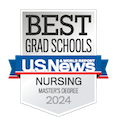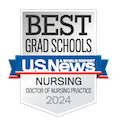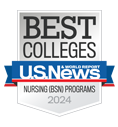Alumna serves working class communities through occupational health
The first in her family to go to college, Ariana Spiewak, MSN, FNP-C, knew she wanted a career that let her engage with working class populations. A recent alumna (MSN 2017) from the University of Michigan School of Nursing (UMSN) primary care family nurse practitioner program with a concentration in occupational health nursing, she does just that through her work at an urgent care clinic in the northern Michigan town of Petoskey, Michigan.
Her motivation to pursue occupational health nursing came from an understanding of labor related health concerns. Most of her family worked in the trades – her father was an electrician – and she saw occupational health nursing as a way to serve the community she came from.
Occupational health nursing at UMSN
The occupational health nursing concentration at University of Michigan School of Nursing is part of the University of Michigan Center for Occupational Health and Safety Engineering (COHSE). Through COHSE, nursing students learn alongside students from the School of Public Health and the College of Engineering.
Learning among students from different disciplines at COHSE helped Spiewak develop a useful perspective.
“I loved the opportunity to connect with students in public health, safety engineering, and industrial hygiene,” said Spiewak.
UMSN professor Marjorie McCullagh, PhD, RN, FAAN, directs the occupational health nursing program at the school.
“Since most adults spend up to a third of their time at work, understanding the relationships between work and health is critical to providing high-quality primary care,” McCullagh explained. “This program offers students insights and strategies for optimizing worker health and safety not generally included in primary care training.”
Extracurricular involvement
In 2016 as a student, she found a way to provide care to working class populations by volunteering at the Student-Run Free Clinic (SRFC) in Pinckney, Michigan. There were all levels of medical students volunteering there, and she was able to share some clinical skills that she had already developed in her experience as a nurse with some of the first year medical students.
Her volunteer work at the SRFC pre-dated the School of Nursing’s recent establishment of this location as a clinical site for students. Led by clinical instructor Megan Eagle, MSN, MPH, FNP-BC, School of Nursing faculty and students join medical and dental student volunteers to provide free care to uninsured and underserved residents of Livingston County.
“I was happy to see the School of Nursing become formally connected to this clinic because it’s a great opportunity for students,” Spiewak said.
No such thing as too much clinical experience
While completing her MSN degree, Spiewak worked as a labor and delivery nurse at Beaumont Hospital. With that background, she was excited to take on an independent study during the summer of 2016.
“I wanted to do additional clinical hours to really, really know that I felt comfortable in clinic.”
She did her independent study with two faculty members who work with high-risk youth, Michelle Pardee, DNP, FNP-BC, at the Taylor Teen Clinic and Elizabeth Kuzma, DNP, FNP-BC, at the Regional Alliance for Healthy Schools.
Kuzma remembers Spiewak as a particularly dedicated student.
“In order for her to gain more experience in pediatric and adolescent health, Ariana contacted me to spend additional clinical time with me at my clinical site. Ariana was an extremely motivated student who always wanted to gain the most out of every experience,” Kuzma said.
Spiewak noted that these clinical experiences were important for her professional development.
“I found out during this independent study that I love contraceptive planning,” she recalled. “It was a turning point for me as a student where everything clicked and I felt like, I can do this. I loved empowering people to make decisions for their sexual health.”






